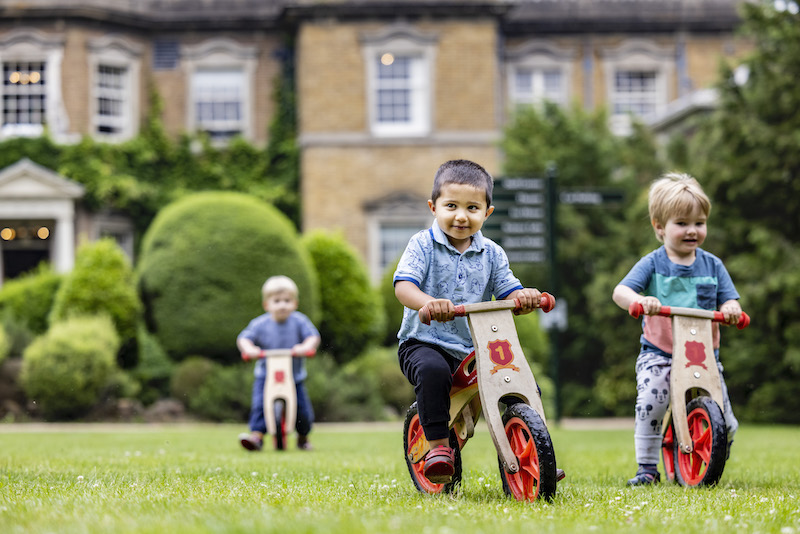The intrinsic and undeniable value of a child-centred approach
Posted on 6th Jun 2022 in School News, Which London School?, Curriculum
Genevieve Mackenzie, Head of Early Years at Hampton Court House, on the benefits of a bespoke curriculum.
“What is essential is that children learn independently, not in bunches; that they learn out of interest and curiosity, not to please appease the adults in power; and that they ought to be in control of their own learning, deciding for themselves what they want to learn and how they want to learn it.”
John Holt
Early years pedagogy has always valued the unique and individual child. The Montessori Method asks teachers to “follow the child” (Maria Montessori). The Early Years Foundation Stage describes the “unique child” (EYFS, 2021). While the Reggio Emilia approach puts children in control of their own education. When we think about early years education from this perspective, it is simple to acknowledge that an individualised approach should be used. But what does it mean to be truly child-centred in your approach to early years education? So much of what teachers do today are driven and determined by assessments. Where their focus is on pushing children to conform, gaining the knowledge they need to meet certain criteria and planning lessons and activities to ensure they do. Whilst I understand and endorse necessary assessments that are required to protect children from falling behind and ensure they are making progress, assessment should be used to create each child’s curriculum. I truly believe that providing a bespoke and truly child-centred approach has the biggest impact and ensures children make the best progress.
Creating a bespoke curriculum for each individual child is no easy task. “Child-centered teaching is placing the pupil at the centre of the learning process in classroom” (Gravoso, Pasa, Labra & Mori, 2008). “The teacher provides pupils with opportunities to learn independently and from one another and coaches them in the skills they need to do so effectively” (Collins & O’Brien, 2003). At Hampton Court House, we have managed to create this using a variety of pedagogues, including the EYFS and Forest School as well as Montessori and Reggio Emilia influences. It requires a dedicated team with exceptional teaching skills, differentiation and flexibility across the curriculum. In addition, consideration of every child’s needs and the resources to support this tailored approach. We know that all children learn differently, they have different interests and different needs. When we assess children, we consider everything we need to create opportunities for learning.
“Being child-centred is about elevating the status of children’s interests, rights, and views in the work of your organisation. It involves considering the impact of decisions and processes on children, and seeking their input when appropriate to inform your work.” (Office of the Children’s Commissioner website) Some examples of how we do this: For a child who is interested in writing, we help them to develop their fine motor coordination by introducing them to the Montessori ‘practical life materials’. For a toddler who loves trains and starting to distinguish colours we provide them with different coloured trains. Our project work may stem from a question that a child asks – “where do animals live” creates a project around animal habitats. For a child who learn better outdoors, we use the forest school approach.
What makes this child-centred approach so important? Children learn by doing and through their experiences and play. When they are interested, they concentrate and when they choose, they feel valued and a sense of belonging. They intrinsically access a better variety of activities, which ensures a holistic education. They develop independence, learn to make decisions and problem solve. They develop self-respect and have a deeper understanding of themselves and the world they live in.
Someone asked me at an open morning: what sets Hampton Court House apart from all the other schools? I have to admit that I felt rather delighted to reply. But my reply was not solely about our very distinct location; for those of you who have not had the opportunity to visit us yet, Hampton Court House is a manor house with front steps that lead onto beautiful and majestic gardens, and our back steps lead onto Bushy Park. This is a place where magic happens. I can’t think of anywhere else in the world where a stag comes to the window and bows his head to ask for a piece of fruit – this happens daily and gives me goosebumps every time. But the second reason we are so distinctive is our wonderfully bespoke and child-centred ethos. That we take time to reflect on and consider every decision we make, placing the children at the centre. This ensures that every child is supported to have the freedom to create their own excellent programme that enables them to reach their own potential and to be their own person.
“Let the children be free; encourage them; let them run outside when it’s raining; let them remove their shoes when they find a puddle of water; and, when the grass of the meadows is damp with dew, let them run on it and trample it with their bare feet; let them rest peacefully when a tree invites them to sleep beneath its shade; let them shout and laugh when the sun wakes them in the morning as it wakes every living creature that divides its day between waking and sleeping.”
Maria Montessori
This article first appeared in the 2022/23 edition of Which London School? & the South-East, which you can read in full below: